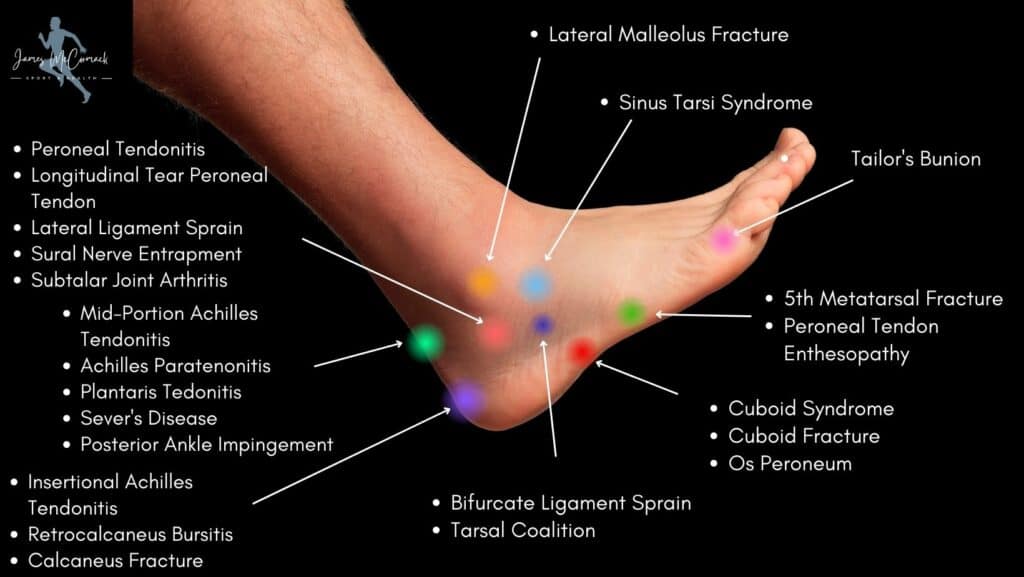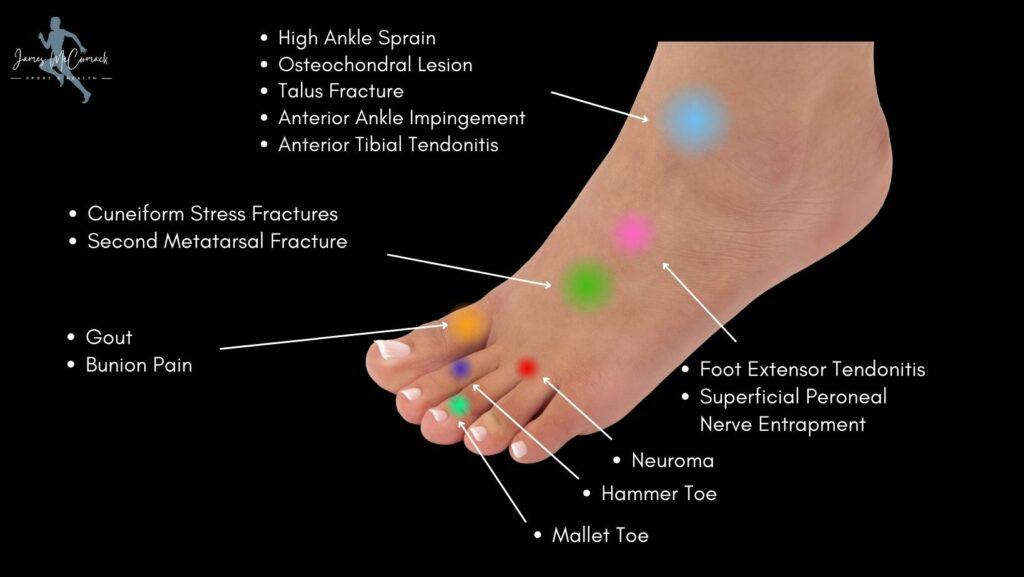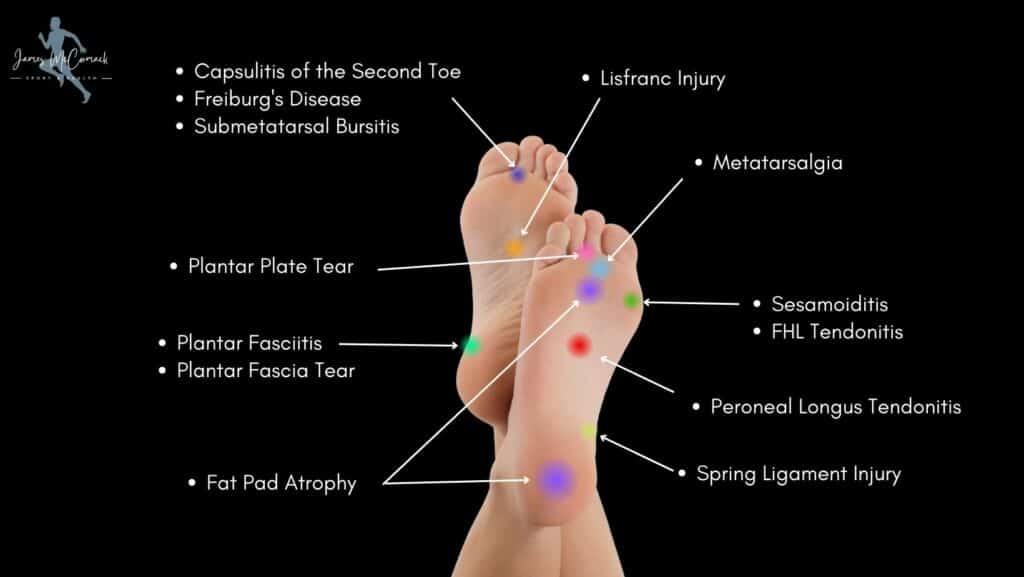Best Running Shoes For Knee Arthritis
Read More >
Foot pain can be debilitating, and several conditions can cause pain in certain aspects of the foot. This article provides a comprehensive Foot Pain Chart for all sides of the foot and links to more in-depth articles on the symptoms, causes, diagnosis and treatment for each condition.
Our foot pain charts have been created by a foot and ankle expert, James McCormack, who has extensive experience in the diagnosis and treatment of all conditions within this article.

Mid-Portion Achilles Tendonitis – Achilles tendon pain usually occurring in the middle portion due to overuse, overload or biomechanical factors.
Achilles Paratenonitis – Inflammation and pain occurring between the Achilles Tendon and the tendon sheath, resulting in pain on the entire length of the tendon.
Plantaris Tendonitis – A long, thin tendon that runs along the inner aspect of the Achilles Tendon and can cause pain along the medial Achilles.
Sever’s Disease – Also known as Calcaneal Apophysitis, this condition affects children and teenagers at the Achilles Tendons insertion to the heel bone.
Posterior Ankle Impingement – A condition affecting the back of the ankle joint, usually resulting from a bony growth, extra bone or soft tissue impingement.
Insertional Achilles Tendonitis – pain and irritation of the Achilles Tendon as it inserts onto the Calcaneus bone.
Peroneal Tendonitis – an overload or overuse of the Peroneal Tendons that results in inflammation and pain on the outer heel and ankle
Longitudinal Tear of the Peroneal Tendon – an uncommon condition of the Peroneal Tendon that often requires surgical repair.
Lateral Ligament Sprain – the most common type of ankle sprain that affects up to 3 of the lateral ligaments.
Sural Nerve Entrapment – a branch of the sciatic nerve that results in pain at rest and with activity.
Subtalar Joint Arthritis – forming part of the ankle joint; this condition can result from previous ankle sprains, trauma, obesity or previous surgery.
Lateral Malleolus Fracture – a fracture of the lower aspect of the outer ankle bone (fibula) that can occur innocuously.
Sinus Tarsi Syndrome – located beside the lateral ankle ligaments- often occurs secondary to a lateral ankle sprain.
Bifurcate Ligament Sprain – is a lesser-known ligament often associated with unresolved severe ankle sprains.
Tarsal Coalition – a congenital condition that involves the attachment of two tarsal bones from birth.
Cuboid Syndrome – is an irritation or subluxation of the cuboid bone, often over-diagnosed.
Cuboid Fracture – an uncommon bone break known as the ‘nutcracker’ fracture.
Os peroneum – an accessory bone found in the Peroneus Longus Tendon on the outer aspect of the midfoot
5th Metatarsal Fracture – a bone break to the outer toe that requires imaging to determine the severity of injury.
Peroneal Enthesopathy – a form of tendon pain that affects the peroneal tendon as it attaches to the 5th metatarsal.
Tailor’s Bunion – also known as a bunionette, this condition causes the small toe to turn inwards.

High Ankle Sprain – usually results from rotation sprains to the ankle where the foot is held in a fixed position and is much slower to heal than a lateral ankle sprain.
Anterior Ankle Impingement – also known as a footballer’s ankle, causes pain on the front of the ankle when bringing the knee over the foot or kicking a ball.
Osteochondral lesion to the talus – changes in the integrity of the cartilage of the talus bone that provides similar symptoms to an anterior ankle impingement, but patients often describe the pain as deep in the ankle.
Talus Fracture – a fracture of the Talus bone are rare and slow to heal, often the result of snowboarding accidents or falls from a significant height.
Anterior Tibial Tendonitis – a less common form of tendon pain that is often felt when walking.
Cuneiform Fracture – there are 3 cuneiform bones and while fractures are rare, they occur most commonly in the medial cuneiform.
Second Metatarsal Fracture – a common fracture in runners, especially in females with a spike in their running volume.
Foot Extensor Tendonitis – causes tendon pain all along the top of the foot, making lifting the foot upwards (dorsiflexion) uncomfortable.
Superficial Peroneal Nerve Entrapment – nerve irritation supplying sensation to the top of the foot that can result in constant pain and sensitivity.
Gout – a condition that mostly affects the big toe in males that can cause constant excruciating pain.
Bunion Pain – a genetic condition that results in the deviation of the big toe away from the midline.
Morton’s Neuroma – a condition that causes pain, numbness and the sensation of a pebble in your shoe between the 3rd and 4th metatarsals.
Hammer Toe – a contraction of the PIP joints that results in curling of the toes.
Mallet Toe – a contraction of the DIP joints that results in curling of the tip of the toes.

Fat Pad Atrophy – changes in the thickness of the fatty tissue protecting the heel bone.
Spring Ligament Injury – a ligament spanning the bottom of the foot that plays a vital role alongside the Plantar Fascia to provide structural integrity to the foot.
Plantar Fasciitis – an overload to the plantar fascia that leads to pain on the heel with impact activities. Symptoms are often worse in the morning after activity.
Plantar Fascia Tear – a tear to the plantar fascia that is normally sudden in onset.
Peroneal Longus Tendonitis – attaching to the underside of the 1st metatarsal; this is an uncommon cause of plantar foot pain.
Lisfranc Injury – a serious injury to the 2nd metatarsal joint that is commonly associated with bruising under the foot.
FHL Tendonitis – a long tendon to the big toe, often overloaded by jumping activities such as ballet or gymnastics.
Metatarsalgia – a broad term to describe pain within the metatarsophalangeal joints of the forefoot.
Capsulitis of the second toe – a capsule surrounds the joint of the second toe, and this can become painful and inflamed when overloaded.
Plantar Plate Tear – the plantar plate are important ligaments that stabilises the metatarsal heads. Tears to these ligaments can cause secondary issues such as hammertoes.
Freiburg’s Disease – causes a change in the structure of the metatarsal head where instead of having a rounded head, it begins to flatten with sharper edges.
Sesamoiditis – two small floating bones sit within the Flexor hallucis longus tendon that can cause significant discomfort when overloaded.

Medial Malleolus Fracture – a common fracture site that occurs from running, ankle dislocation or trauma.
Posterior Tibial Tendonitis – an inflamed tendon on the inner ankle that can cause pain when walking, standing or running.
FHL Tendonitis – often misdiagnosed as Posterior Tibial Tendon dysfunction and frequently seen in ballet dancers.
Plantar Fasciitis – the most common cause of heel pain that leads to morning stiffness and increase pain after impact activity.
Baxter’s Nerve Entrapment – causes 20% of all heel pain and is often misdiagnosed as Plantar Fasciitis.
Calcaneus Stress Fracture – occurs in only 2% of all fractures and is often referred to as the ‘lovers’ fracture due to falling from a height such as a balcony.
Tarsal Tunnel Syndrome – a nerve irritation that can cause inner ankle and foot pain.
Deltoid Ligament Sprain – a large web of ligaments spanning the inner ankle joint, a less common type of ankle sprain.
Medial Malleolus Bursitis – a rare injury caused by tight-fitting ski boots or direct impact to the area.
Mueller Weiss Syndrome – condition affecting the navicular bone.
Accessory Navicular Syndrome – an additional navicular bone that most people go their entire life without knowing they have unless it becomes painful.
Navicular Fracture – a fracture that occurs in high-impact sports that requires a quick diagnosis and good management due to its poor blood supply.
Kohler’s Disease – spontaneous osteonecrosis of the navicular bone that causes pain in the midfoot and surrounding tarsal bones.
Mid-Portion Plantar Fasciitis – also known as non-insertional plantar fasciitis that causes pain in the midfoot.
Midfoot Arthritis – arthritis of the tarsal bones in the midfoot that causes stiffness and discomfort in the morning and when walking.
Bunion Pain – a condition of the big toe that leads it to turn outwards, crossing the second toe in severe cases.
Turf Toe – a hyperextension injury of the ligaments and joint capsule of the big toe joint caused by sprinting or slipping.
Hallux Rigidus – this is arthritis of the big toe joint that leads to a reduced range of motion and pain when walking or running.
Tennis Toe – a haematoma of the nail caused by repeated trauma to the nail bed of the big toe against a tennis shoe.
Skiers Toe – a haematoma of the nail caused by repeated trauma to the nail bed of the big toe against a ski boot.
James McCormack is a foot and ankle specialist who created all of these foot pain charts, which are copyrighted. Please do not reshare these images without crediting them.
This article is not a replacement for medical advice, and we recommend consulting with a medical professional such as James McCormack if you have foot or ankle pain. James offers Online Physiotherapy Appointments weekly or face-to-face appointments in his Fulham clinic.